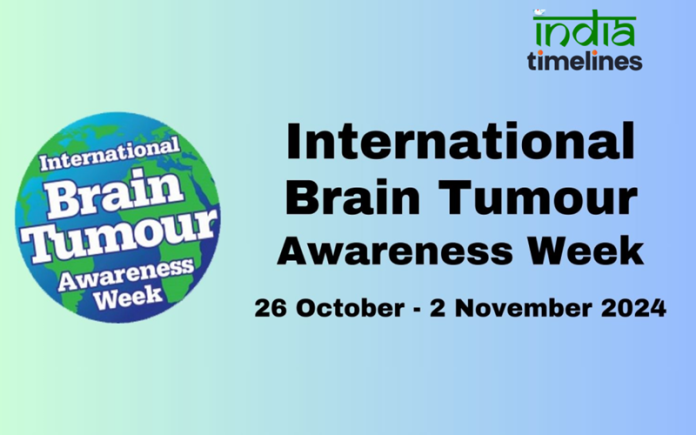
International Brain Tumour Awareness Week is an annual event dedicated to raising awareness about brain tumours and their impact on patients, caregivers, and healthcare providers. Held in the last week of October, this initiative seeks to promote education, support research, and encourage communities to advocate for better treatment and care for those affected by brain tumours.
Brain tumours are among the most serious and challenging forms of cancer. They can affect people of any age, gender, or background, and their symptoms often mimic less severe conditions, leading to delays in diagnosis and treatment. Awareness campaigns like International Brain Tumour Awareness Week play a crucial role in demystifying the condition, offering resources to those in need, and highlighting the importance of early diagnosis and cutting-edge research.
This article will explore the significance of this awareness week, the types of brain tumours, the common symptoms, the challenges faced by patients, ongoing research, and how individuals can get involved to make a difference.
Understanding Brain Tumours
What Is a Brain Tumour?
A brain tumour is an abnormal growth of cells within the brain or the surrounding structures. These tumours can either be benign (non-cancerous) or malignant (cancerous), with malignant tumours often posing more significant risks due to their potential to invade nearby tissues or spread to other parts of the brain and spine.
Brain tumours are categorized into two main types:
- Primary brain tumours: Tumours that originate in the brain.
- Secondary brain tumours (metastatic): Tumours that begin in another part of the body and spread to the brain.
Types of Brain Tumours
There are many different types of brain tumours, each with unique characteristics and treatment approaches. Some of the most common include:
- Gliomas: These originate in the glial cells, which support and protect the brain’s neurons. Gliomas account for approximately 30% of all brain tumours and 80% of malignant brain tumours.
- Astrocytomas: A subtype of glioma, including the aggressive glioblastoma multiforme, which is one of the most challenging brain cancers to treat.
- Oligodendrogliomas: Tumours arising from oligodendrocytes, another type of glial cell.
- Ependymomas: Tumours that develop in the lining of the brain’s ventricles or spinal cord.
- Meningiomas: These tumours develop from the meninges, the layers of tissue covering the brain and spinal cord. Meningiomas are usually benign but can become problematic if they press on surrounding structures.
- Pituitary adenomas: Tumours that form in the pituitary gland, responsible for regulating various hormones in the body. While most are benign, they can disrupt normal hormone production.
- Medulloblastomas: These are fast-growing malignant tumours typically found in children. They arise in the cerebellum, the part of the brain responsible for balance and coordination.
- Schwannomas: Benign tumours that develop from Schwann cells, which produce the myelin sheath around nerves. Acoustic neuromas, a type of schwannoma, can affect hearing and balance.
The Importance of International Brain Tumour Awareness Week
Raising Awareness
One of the most significant goals of International Brain Tumour Awareness Week is to spread knowledge about brain tumours and their effects. Many people are unaware of the symptoms, risk factors, and available treatment options, leading to delays in seeking medical advice. Early detection is crucial for improving outcomes, particularly for malignant tumours like glioblastomas, where rapid progression can occur.
By organizing events, sharing personal stories, and leveraging the power of social media, this awareness week shines a spotlight on the issue, urging individuals to be mindful of symptoms and consult healthcare professionals when necessary.
Supporting Patients and Caregivers
Living with a brain tumour is incredibly challenging, both for the patient and their caregivers. The physical, emotional, and financial toll can be overwhelming. International Brain Tumour Awareness Week serves as a platform to support those affected by this condition, offering resources such as counseling, support groups, and information about treatment options.
It also provides a sense of community, reminding patients and caregivers that they are not alone in their journey. Sharing experiences can foster hope, reduce isolation, and offer practical advice for managing the challenges that arise during diagnosis, treatment, and recovery.
Promoting Research and Innovation
Another key aspect of International Brain Tumour Awareness Week is its focus on advancing research. Brain tumours are notoriously difficult to treat due to the brain’s complexity and the blood-brain barrier, which prevents many drugs from reaching the tumour. However, significant progress is being made in the fields of neuro-oncology, neurosurgery, and immunotherapy.
Raising funds for research is a central aim of this awareness week. Research into the causes, risk factors, genetic predispositions, and innovative treatments for brain tumours can lead to breakthroughs that offer new hope for patients. Awareness events often include charity runs, auctions, and fundraising campaigns that contribute to research institutions and hospitals dedicated to studying brain tumours.
Recognizing the Symptoms of Brain Tumours
One of the challenges in diagnosing brain tumours is that their symptoms can be non-specific and resemble other conditions. However, recognizing the warning signs can lead to earlier diagnosis and better treatment outcomes. Some of the common symptoms include:
- Persistent Headaches: Headaches that are more severe in the morning or worsen over time can be a red flag, especially if they don’t respond to typical treatments.
- Seizures: Sudden, unexplained seizures in an adult without a history of epilepsy may indicate the presence of a brain tumour.
- Nausea and Vomiting: Persistent nausea or vomiting, especially when coupled with other symptoms, could be related to increased intracranial pressure caused by a tumour.
- Cognitive or Personality Changes: Difficulty concentrating, memory problems, confusion, or sudden changes in personality can sometimes signal a brain tumour.
- Balance and Coordination Issues: Tumours in or near the cerebellum can affect balance, coordination, and fine motor skills.
- Vision or Hearing Problems: Changes in vision, such as blurriness or double vision, or hearing loss in one ear, could be related to a tumour pressing on specific cranial nerves.
- Weakness or Numbness: A tumour affecting motor pathways can cause weakness or numbness on one side of the body.
It is important to remember that these symptoms can result from various other conditions, but if they persist or worsen, it is critical to consult a healthcare provider for further evaluation.
Treatment Options for Brain Tumours
Treatment for brain tumours varies depending on the type, size, location, and grade of the tumour, as well as the patient’s overall health. Some of the most common treatment approaches include:
- Surgery: For many brain tumours, surgery is the first line of treatment. The goal is to remove as much of the tumour as possible without damaging surrounding healthy brain tissue. In some cases, complete removal may not be feasible, but even partial removal can alleviate symptoms and improve quality of life.
- Radiation Therapy: This treatment uses high-energy beams, such as X-rays, to target and destroy tumour cells. It is often used after surgery to kill any remaining cancerous cells or as a standalone treatment for inoperable tumours.
- Chemotherapy: Chemotherapy involves using drugs to kill cancer cells or stop them from growing. While it is effective for some types of brain tumours, not all chemotherapy drugs can cross the blood-brain barrier, which limits its effectiveness in certain cases.
- Targeted Therapy: This newer form of treatment focuses on attacking specific genetic mutations or molecular markers in tumour cells. By targeting only the cancer cells, this approach aims to minimize damage to healthy tissues.
- Immunotherapy: Immunotherapy boosts the body’s immune system to recognize and fight cancer cells. Although still in the experimental stage for many brain tumours, immunotherapy is a promising area of research.
- Supportive and Palliative Care: In addition to these treatments, patients may receive supportive care to manage symptoms such as headaches, seizures, and cognitive issues. Palliative care focuses on improving the quality of life for patients, regardless of the stage of their illness.
How to Get Involved in International Brain Tumour Awareness Week
There are many ways individuals can participate in International Brain Tumour Awareness Week and help make a difference. Whether you are a patient, caregiver, healthcare professional, or advocate, your involvement can contribute to the overall mission of raising awareness and supporting those affected by brain tumours. Some ways to get involved include:
- Participate in Local Events: Many communities host events such as charity walks, runs, or educational seminars during this week. Participating in these events helps raise funds for research and provides support to those impacted by brain tumours.
- Spread Awareness on Social Media: Use your social media platforms to share information about brain tumours, personal stories, and event details. The more people who know about the signs and symptoms, the better the chances for early diagnosis and treatment.
- Donate to Brain Tumour Research: Many organizations focus on researching brain tumours and developing new treatments. Donating to these organizations can support the advancement of knowledge and provide hope for future patients.
- Volunteer: Consider volunteering your time with a local or national brain tumour organization. Whether you’re helping organize events, providing support to patients and families, or spreading information, your contribution can make a meaningful impact.
- Advocate for Policy Change: Advocating for better healthcare policies, increased funding for research, and improved access to treatments can create lasting change in how brain tumours are addressed on a systemic level.
India Time Lines
Conclusion
International Brain Tumour Awareness Week is a critical initiative in the global fight against brain tumours. By raising awareness, supporting patients and caregivers, promoting research, and advocating for policy changes, this week of action contributes to better outcomes for those affected by brain tumours. Everyone can play a part in spreading knowledge and offering hope, bringing us closer to a future where brain tumours are more manageable and less devastating.
With continued awareness, community support, and medical advancements, we can work towards a world where brain tumours are diagnosed early, treated effectively, and ultimately cured.




































